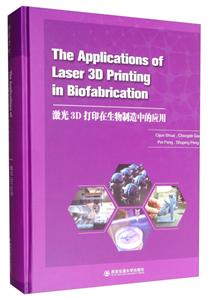激光3D打印在生物制造中的应用
内容简介
[
It has long been one dream of mankind to repair or reconstruct the defective tissues/organs by using biomedical implants, which have similar shape, structure and function to the natural tissues/organs. As the world’s most populous country, China has entered the aging society since the end of the 20th century, and is expected to supplant Japan as the world’s most aging country in 2030. The aged is a highrisk and vulnerable population of serious diseases and accidental injuries because of the decline of physiological function, weak control over environment and the phenomenon of “empty nest”. As a result, trssue/organ defects are growing rapidly and there has been an ever-increasing demand for biomedical implants. In order to repair the defective tissues/organs, a biomedical implant should not only mimic the material characteristics and gradient structure of the defective sites, but also have sufficient mechanical properties to support cells and withstand complex stresses inthe physiological environment. Meanwhile, the implant should possess controllable degradation rate and favorable osteoinductivity. These complex structures, harsh performance and individual differences put forward great challenges for the fabrication methods of biomedical implants. So far, biomedical implants are fabricated mainly by forging, casting and machining, which requires not only complex molds but also high cost for single-piece production. More importantly, traditional fabrication methods are difficult to obtain the gradient structure and performance of implants. Therefore, it has become a huge challenge to manufacture personalized biomedical implants for the repair and regeneration of defective tissues/organs.
]
目录
Chapter Ⅰ Low-dimensional nanomaterials reinforced biomaterials by laser 3D printingNanodiamond reinforced polyvinylidene fiuoride/bioglass scaffolds for bone tissue engineeringGraphene oxide as an interface phase between polyetheretherketone and hydroxyapatite fortissue engineering scaffoldsA combined nanostructure constructed by graphene and boron nitride nanotubesreinforces ceramic scaffoldsA space network structure constructed by tetraneedlelike Zn0 whiskers supporting boron nitride nanosheets to enhance comprehensive properties of poly(L-lacti acid) scaffoldsChapter Ⅱ Oxides reinforced biomaterials by laser 3D printingBiosilicates scaffolds for bone regeneration: infiuence ofintroducing Sr0A mesoporous silica composite scaffold: cell behaviors, biomineralization andmechanicalpropertiesMgO whiskers reinforced poly (vinylidene fiuoride) scaffoldsChapter Ⅲ Alloying elements in biomedical metals by laser rapid solidificationLaser rapid solidification improves corrosion behavior of Mg-Zn-Zr alloyMicrostructure evolution and biodegradation behavior oflaser rapid solidified Mg-Al-Zn alloyInfluence of alloying treatment and rapid solidification on the degradation behavior and mechanical properties of MgPreparation and characterization of laser-melted Mg-Sn-Zn alloys for biomedical applicationRare earth element yttrium modified Mg-Al-Zn alloy: microstructure, degradation properties andhardness……Chapter Ⅳ Liquid phase-assisted densification in laser 3D printingChapter Ⅴ Combination of different types of biomaterials by laser 3D printing
封面

书名:激光3D打印在生物制造中的应用
作者:冯佩 彭淑平
页数:368
定价:¥148.0
出版社:西安交通大学出版社
出版日期:2018-03-01
ISBN:9787569304442
PDF电子书大小:132MB 高清扫描完整版
资源仅供学习参考,禁止用于商业用途,请在下载后24小时内删除!

